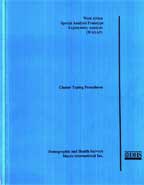- PUBLICATIONS
- JOURNAL ARTICLES
- ACCESS PUBLICATIONS
Publications Summary
- Document Type
- Spatial Analysis Reports
- Publication Topic(s)
- Geographic Information
- Country(s)
- Benin, Burkina Faso, Cameroon, CAR, Cote d'Ivoire, Ghana, Liberia, Mali, Niger, Nigeria, Senegal, Togo
- Language
- English
- Recommended Citation
- Rutstein, Shea O. 2000. West Africa Spatial Analysis Prototype Exploratory Analysis: Cluster Typing Procedures. DHS Spatial Analysis Reports No. 4. Calverton, Maryland, USA: Macro International
- Download Citation
- RIS format / Text format / Endnote format
- Publication Date
- February 2000
- Publication ID
- SAR4
Download
 West Africa Spatial Analysis Prototype Exploratory Analysis: Cluster Typing Procedures (PDF, 460K)
West Africa Spatial Analysis Prototype Exploratory Analysis: Cluster Typing Procedures (PDF, 460K)
Download this publication
There is no printed copy available to order.
